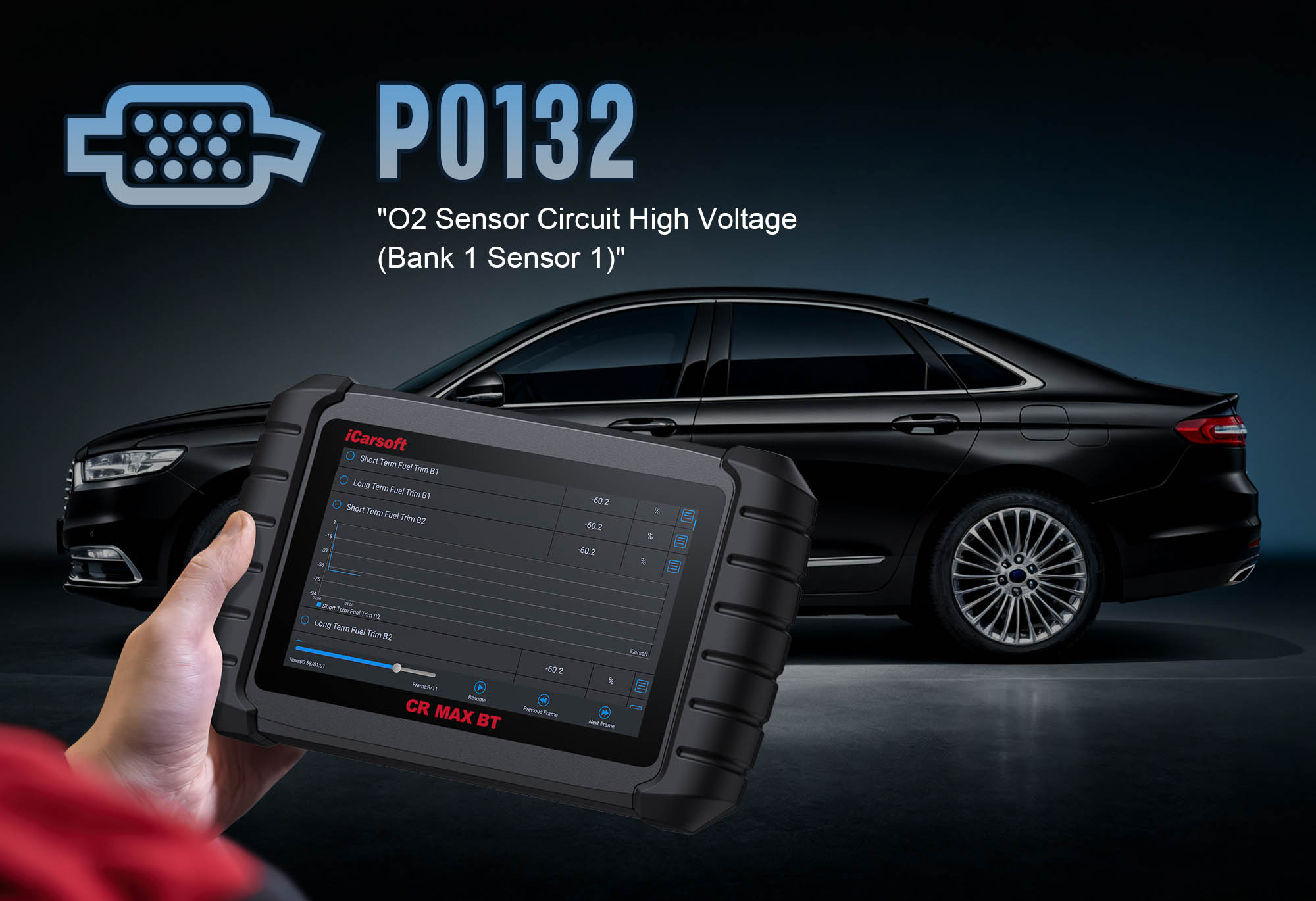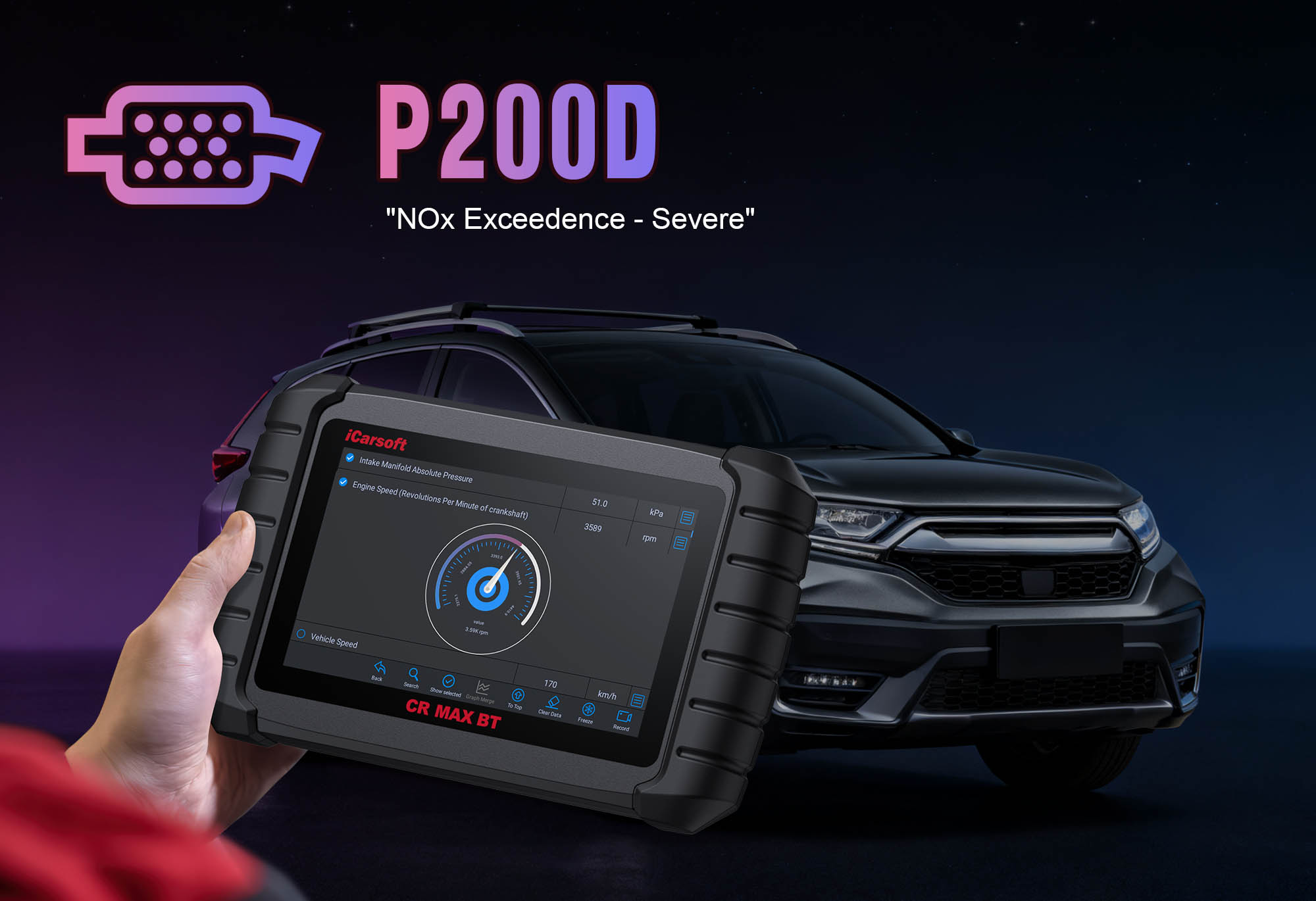Diagnose & Clear P0132 with iCarsoft CR MAX BT: Fix O2 Sensor Circuit High Voltage (Bank 1, Sensor 1)
If your check engine light illuminates and a scan returns P0132, your vehicle’s emissions and fuel systems are signaling a critical issue with oxygen sensor performance. This OBD-II code stands for "Oxygen Sensor Circuit High Voltage (Bank 1, Sensor 1)"—indicating the Engine Control Module (ECM) is receiving an abnormally high voltage signal (above 0.9V) from the upstream oxygen sensor in Bank 1, preventing accurate air-fuel mixture regulation.
Upstream oxygen sensors (mounted before the catalytic converter) monitor unburned fuel in exhaust gases, sending voltage signals (0.1–0.9V) to the ECM to adjust fuel injection. A "rich" signal (0.8–0.9V) tells the ECM to reduce fuel, while a "lean" signal (0.1–0.2V) triggers more fuel. When P0132 occurs, Bank 1’s upstream sensor stays in a high-voltage range, tricking the ECM into thinking the mixture is perpetually rich—leading to reduced fuel economy, increased emissions, and potential catalytic converter damage.
Basic scanners may only confirm "O2 sensor high voltage" but lack the precision to analyze signal patterns or isolate wiring vs. sensor faults. The iCarsoft CR MAX BT—with its wireless waveform analysis, real-time voltage monitoring, and circuit testing—solves this. Let’s explore how to diagnose and resolve P0132 using this advanced tool.
 iCarsoft CR MAX BT displaying Bank 1, Sensor 1 voltage waveform and fuel trim data for P0132 diagnosis
iCarsoft CR MAX BT displaying Bank 1, Sensor 1 voltage waveform and fuel trim data for P0132 diagnosis
Understanding P0132: Causes & Key Symptoms
A P0132 code disrupts air-fuel balance in Bank 1, leading to noticeable performance issues. Recognizing these symptoms helps target your diagnosis:
Key Symptoms of P0132
-
Check Engine Light: Illuminates when Bank 1, Sensor 1 voltage exceeds 0.9V for 3+ minutes of driving.
-
Poor Fuel Economy: The ECM reduces fuel injection to correct the "rich" signal, causing lean misfires and 10–15% lower MPG.
-
Rough Idle & Hesitation: A lean mixture in Bank 1 creates uneven combustion, leading to vibrations or lag during acceleration.
-
Catalytic Converter Damage Risk: Unburned fuel from misfires can overheat the converter, shortening its lifespan.
-
Failed Emissions Tests: High nitrogen oxide (NOx) levels from lean combustion cause test failures.
-
Limp Mode Activation: Severe cases trigger ECM safeguards, limiting RPM to prevent engine damage.
Common Causes of P0132
|
Cause
|
Description
|
|
Faulty Upstream O2 Sensor (Bank 1, Sensor 1)
|
Internal electrical failure (shorted heater or sensing element) causes stuck high voltage—accounts for ~45% of P0132 cases.
|
|
Wiring Short Circuit
|
Damaged wires (frayed insulation touching 12V components like exhaust heat shields) force high voltage into the sensor circuit.
|
|
Corroded Connector
|
Moisture or rust in the sensor plug creates resistance, skewing voltage readings—common in undercarriage-mounted sensors.
|
|
Fuel System Issues
|
A rich mixture (leaking injectors or stuck fuel pressure regulator) floods the sensor with unburned fuel, causing false high voltage.
|
|
ECM Malfunction (Rare)
|
A faulty ECM misinterprets normal sensor voltage as "high," usually paired with other electrical codes (e.g., P0606).
|
Why iCarsoft CR MAX BT Excels at Diagnosing P0132
The CR MAX BT outperforms basic tools with features tailored to O2 sensor diagnostics—critical for pinpointing P0132’s root cause:
Wireless Waveform Analysis
Streams real-time voltage patterns to your device, identifying if the signal is truly stuck high (flat line >0.9V) or intermittently spiking.
Dual Bank Comparison
Displays side-by-side data for Bank 1/Bank 2 O2 sensors, fuel trim, and injector pulse width to isolate Bank 1 issues.
Sensor Heater Circuit Testing
Verifies the sensor’s heater element (critical for quick warm-up) to rule out cold-sensor false readings.
Vehicle-Specific Diagrams
Preloaded 3D schematics show Bank 1 layouts, O2 sensor locations, and wiring paths for 80+ makes (Toyota, Ford, BMW, Hyundai).
Circuit Continuity & Short Detection
Pinpoints wiring faults (shorts, breaks) with precision, eliminating guesswork during diagnostics.
Cloud-Based Updates
Automatic software updates ensure compatibility with new O2 sensor technologies (e.g., wide-band sensors).
Step-by-Step: Diagnose P0132 with iCarsoft CR MAX BT
-
1. Connect & Confirm the Code
Plug the CR MAX BT into your vehicle’s OBD-II port and pair it with your smartphone/tablet via the iCarsoft app (Bluetooth setup takes 30 seconds).
Select your vehicle using Auto VIN Scan (reads VIN instantly) or manual entry (make/model/year/engine).
Navigate to Engine > Fault Codes > Read Codes to confirm P0132. Tap Code Details for vehicle-specific insights (e.g., "Toyota: Bank 1, Sensor 1 Voltage = 1.02V – Exceeds Max Threshold").
-
2. Identify Bank 1 & Locate the O2 Sensor
Use the CR MAX BT to avoid guesswork:
Bank 1 Identification:
Go to Component Location > Engine > Cylinder Banks. For V-engines, Bank 1 = cylinders closest to the front (e.g., V6: Bank 1 = 1-2-3, Bank 2 = 4-5-6). For inline engines, Bank 1 = the only bank.
Sensor Location:
Navigate to Component Location > Engine > Exhaust System > O2 Sensor (Bank 1, Sensor 1). The app displays a 3D diagram: Upstream sensors are mounted in the exhaust manifold or header, before the catalytic converter.
-
3. Analyze Live O2 Sensor & Fuel Trim Data
The CR MAX BT’s real-time data confirms the high voltage issue:
Start the engine and let it reach operating temperature (10–15 minutes).
In the app, go to Engine > Live Data > Exhaust System and select Bank 1 metrics:
- "O2 Sensor Voltage (Bank 1, Sensor 1)": Normal = 0.1–0.9V (rapid fluctuations). P0132 = steady >0.9V.
- "Short-Term Fuel Trim (STFT) – Bank 1": Normal = -5% to +5%. P0132 = STFT stuck at -10% to -20% (ECM leaning aggressively).
Compare to Bank 2: If only Bank 1 shows high voltage/negative trim, the issue is isolated to Bank 1 components.
-
4. Inspect the O2 Sensor & Connector
Physical damage or corrosion is often the cause—check with guidance from the CR MAX BT:
Sensor Inspection:
Locate the sensor using the app’s diagram. Check for:
- Oil contamination (black soot = rich mixture; white deposits = oil leak).
- Physical damage (cracks from road debris).
Connector Check:
Disconnect the sensor’s plug. Look for:
- Corrosion (white/green deposits) on terminals.
- Bent pins or water intrusion (common in undercarriage locations).
Clean terminals with electrical contact cleaner; straighten bent pins carefully.
-
5. Test the O2 Sensor’s Electrical Function
A faulty sensor is a top cause—test it with the CR MAX BT:
Resistance Test:
Turn off the engine and disconnect the sensor connector.
Navigate to Special Functions > Sensors > O2 Sensor Test in the app.
Measure resistance across the sensor’s signal pins: Normal = 10–25 ohms. 0 ohms (short) = replace the sensor.
Heater Circuit Test:
Check resistance across the heater pins (separate from signal pins). Normal = 5–15 ohms (varies by vehicle). Open/short = replace sensor.
-
6. Diagnose Wiring for Short Circuits
A short forces high voltage into the circuit—test with the CR MAX BT:
Short to 12V Test:
Navigate to Special Functions > Electrical Tests > Short Circuit Test in the app.
Connect one test lead to the sensor’s signal wire (at the connector) and the other to ground.
A reading <5 ohms = wire is shorted to 12V (look for damaged insulation near 12V components like exhaust manifold heat shields).
Continuity Test:
Verify wiring between the sensor and ECM (use the app’s wiring diagram). >1 ohm resistance = damage—repair with heat-shrink connectors.
-
7. Check for Fuel System Issues
A rich mixture can trigger P0132—diagnose with the CR MAX BT:
Fuel Pressure Test:
Connect a gauge to the fuel rail (use the app’s diagram to locate the port).
Normal pressure = 35–50 psi (varies by vehicle). High pressure = stuck regulator (replace to reduce fuel delivery).
Injector Balance Test:
Go to Special Functions > Fuel System > Injector Balance to check for leaking injectors in Bank 1 (longer pulse width = leak).
-
8. Repair & Clear P0132
Fix the Root Cause:
- Replace the Bank 1, Sensor 1 O2 sensor (use OEM for accuracy—check the app’s Part Lookup).
- Repair shorted wiring with heat-shrink connectors; replace severely damaged harnesses.
- Clean or replace corroded connectors; apply dielectric grease to prevent moisture damage.
- Address fuel system issues (replace regulator or injectors as needed).
Clear the Code: In the app, go to Engine > Fault Codes > Clear Codes to delete P0132.
-
9. Validate the Repair
Confirm the sensor and circuit work correctly:
- Recheck live data—Bank 1, Sensor 1 voltage should fluctuate 0.1–0.9V; STFT = -5% to +5%.
- Take a 20-minute test drive (city + highway) to check for smooth idle and acceleration.
- Re-scan with the CR MAX BT: No P0132 recurrence = successful repair.
Preventing P0132 Recurrence
The CR MAX BT helps maintain reliable O2 sensor performance long-term:
-
Sensor Maintenance: Use the app’s Service Reminder to replace upstream O2 sensors every 60,000–100,000 miles.
-
Fuel Quality: Use Top Tier gasoline to reduce carbon buildup on sensors—avoid low-octane or off-brand fuel.
-
Wiring Protection: Secure sensor wiring away from hot exhaust components using heat-resistant loom tape.
-
Connector Care: Apply dielectric grease annually to O2 sensor plugs to repel moisture and prevent corrosion.
-
Regular Scans: Use the CR MAX BT’s Quick Scan monthly to catch O2 sensor issues before they trigger the check engine light.
Conclusion
P0132’s high O2 sensor voltage in Bank 1 disrupts critical air-fuel balance, but the iCarsoft CR MAX BT simplifies diagnosis with wireless waveform analysis, circuit tests, and bank-specific data. Whether replacing a sensor, repairing a short, or fixing fuel system issues, this tool ensures you resolve the root cause—restoring fuel efficiency and protecting your catalytic converter.
With the CR MAX BT, tackling "O2 sensor high voltage" becomes a precise, streamlined process—keeping your engine running clean and efficient for miles to come.
FAQs About P0132 Code
Q: Can I drive my vehicle with P0132?
A: Yes, but avoid prolonged driving (over 1 week). A stuck high voltage signal causes lean misfires, which can damage the catalytic converter over time. Fix promptly to prevent costly repairs.
Q: How much does it cost to fix P0132?
A: Costs vary by cause: O2 sensor = $70–$150 (DIY); wiring repair = $20–$50; professional labor = $100–$200 (if sensor is hard to access). The CR MAX BT avoids unnecessary ECM or catalytic converter replacement.
Q: Why does P0132 come back after replacing the O2 sensor?
A: Common reasons: 1) Unrepaired wiring short (still sending high voltage); 2) Fuel system issue (rich mixture persists); 3) Corroded connector (not cleaned/replaced); 4) ECM misinterpretation (needs software reset). Re-run the CR MAX BT’s fuel pressure and wiring tests to find leftover issues.
Q: Will a bad O2 sensor heater cause P0132?
A: No—heater circuit issues trigger separate codes (e.g., P0135). However, a failed heater keeps the sensor cold, which may cause intermittent high voltage readings. The CR MAX BT’s heater test will identify this (replace sensor if heater fails).
Q: Can a rich fuel mixture cause P0132?
A: Yes—a truly rich mixture (excess fuel) can drive O2 sensor voltage high, but this should fluctuate with fuel trim adjustments. If voltage is stuck high despite lean trim commands, the sensor or wiring is faulty. Use the CR MAX BT to differentiate between a rich mixture and a sensor fault.

 iCarsoft CR MAX BT displaying Bank 1, Sensor 1 voltage waveform and fuel trim data for P0132 diagnosis
iCarsoft CR MAX BT displaying Bank 1, Sensor 1 voltage waveform and fuel trim data for P0132 diagnosis



